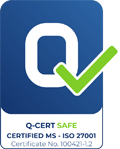Quick Links
Do you need marketing automation?
Marketers are under growing pressure. They are expected to increase revenue and get results, while they have less time and resources on their hands.
Thankfully, marketing automation platforms, like WayMore, are here to help, by handling activities that would otherwise be tedious to carry out manually. Among other things they can streamline, automate, and measure marketing tasks and workflows. By investing in a marketing automation platform it becomes clear that you will be able to tackle some of business’s most pressing and complex challenges, while increasing operational efficiency and growing revenue.
Let’s take a look at how marketing automation platforms are empowering businesses to solve some great challenges.
How to solve business challenges with marketing automation
Challenge #1. Lack of conversions
Not everyone is ready to buy your product or service right now. Sales cycles take time. In some cases, it can take months or even years to move a customer through the sales funnel. So, even though a lead might not be ready to buy right now, they still are a potential customer or a future conversion.
Consumers nowadays want to be educated and informed, before making a purchase. Using marketing automation brands can deliver that, nurturing these leads via multiple channels until they are ready to buy.
Regardless of how lengthy the sales cycle is, through marketing automation you can create funnels to move people closer to buying, serving content that is unique to each stage.
This helps businesses save both time and money as they’re able to use marketing automation to follow up with soft leads, so their sales team can focus on hot leads.
Example: Create a multi-step email series for new leads, starting with a welcome email, followed by educational content like blog posts, webinars, and case studies. Use conditional branching to tailor the content based on the recipient’s actions and interests. Leverage the pre-built email templates offered by marketing automation platforms, like WayMore, to streamline the creation process and ensure a consistent brand experience.
Challenge #2. Lack of engagement and loyalty
With customer expectations on the rise, many brands struggle with engagement and loyalty.
Customers however, not only expect, but also demand, personalized, seamless, and omnichannel communication. And they won’t take no for an answer.
Delivering personalized and seamless customer experiences are all essential aspects of marketing automation platforms. By creating value for customers, businesses are able to engage deeper with customers at all stages of the customer journey, sending them the right messaging at the right time.
And with great customer experiences come strong and meaningful connections, key to fostering brand loyalty.
Example: Send automated birthday wishes or anniversary messages to show appreciation for your customers.
Challenge #3. Lack of time
At the risk of repeating ourselves, it is worth restating that time is a precious commodity. It is, after all, one of marketing’s biggest challenges.
Inefficiencies mean less revenue and profit. If your sales or marketing team is spending time on repetitive manual work, they’re not spending their time as best as they could.
With marketing automation software you can make the most of your time, avoiding repetitive tasks and manual data entry. You then have more time to focus on more strategic work that can improve overall processes, innovate marketing campaigns, and increase the bottom line.
The only thing you have to do is identify the targets and decide on a basic communication flow. Then, automation will handle the rest. From the creation, to the scheduling and sending of many types of emails or other communications.
Marketing automation platforms will also give you the insight you need to refine your strategies, pointing out the inefficiencies and the areas that might need some more attention.
Example: Use marketing automation tools to schedule social media posts in advance, create automated email workflows for lead nurturing and customer onboarding, and automatically sync customer data between different platforms.
Challenge #4. Lack of alignment between sales and marketing
Broadly speaking, both sales and marketing teams work towards the same goal, that of revenue growth. Yet, as each team has access to different types of data about their customers leading to different perceptions on the actions needed to reach the common goal and lack of alignment.
An all-in-one solution, such as a marketing automation platform, can play a key role in bridging this alignment gap, bringing together the data they each hold.
By aligning their efforts and sharing information to design more effective workflows, both teams become more productive. They can also pursue high-quality leads with more success, as they can better identify them and focus their efforts on those with the most purchase potential.
Furthermore, a marketing automation platform can break down the marketing and sales silos, so both teams can collaborate more effectively on campaigns. This way, they ensure that prospects get the right message and the right attention at the right time, providing the best possible experience for the customer.
Example: Use an advanced customer profile platform to automatically build detailed profiles about each lead, including geography, demographics, preferences, and more. This shared data can help both marketing and sales teams prioritize their efforts and focus on the most qualified prospects. For instance, marketing can tailor their messaging and content based on customer preferences, while sales can tailor their approach to match the individual needs and interests of each prospect.
Challenge #5. Lack of revenue
All the above mentioned challenges also have an impact on your bottom line.
Marketing automation gives you all the tools you need to track leads and customers throughout the sales cycle, giving you big picture results. This in turn helps you determine the effectiveness of your marketing campaigns and their impact on revenue.
Recent studies suggest that 77% of CMOs at top-performing companies say the most important reason for implementing marketing automation is revenue growth. Research also states that marketing automation increases sales productivity by 14.5% and reduces marketing overhead by 12.2%.
These numbers are hard to ignore if you’re not already using a marketing automation tool.
Example: Set up goals and track key performance indicators (KPIs) like open rates, click-through rates, conversion rates, and revenue generated. Use this data to identify successful campaigns and make adjustments to improve performance.
Challenges solved.
Today, marketers are under constant pressure to increase revenue and get results with less time and resources. Thankfully, marketing automation platforms are here to help by streamlining, automating, and measuring marketing tasks and workflows in order to increase operational efficiency and grow revenue faster.
FAQs
Marketing automation can help businesses increase conversions by:
- Implementing targeted lead nurturing campaigns.
- Personalizing content based on customer behavior.
- Automating follow-up activities and reducing manual effort. A powerful tool like WayMore can help you automate these processes and streamline your sales funnel.
Marketing automation can help improve customer engagement and loyalty by:
- Delivering personalized experiences and relevant content.
- Using customer segmentation to target specific audiences.
- Providing timely and effective communication channels. With WayMore’s advanced segmentation capabilities, you can easily create targeted campaigns that resonate with your customers.
Marketing automation can help bridge the gap between sales and marketing by:
- Providing a shared platform for data and insights.
- Creating automated workflows that connect lead generation, nurturing, and sales follow-up.
- Encouraging collaboration and communication between teams. WayMore offers a comprehensive suite of tools that can help streamline these processes and improve team alignment.




